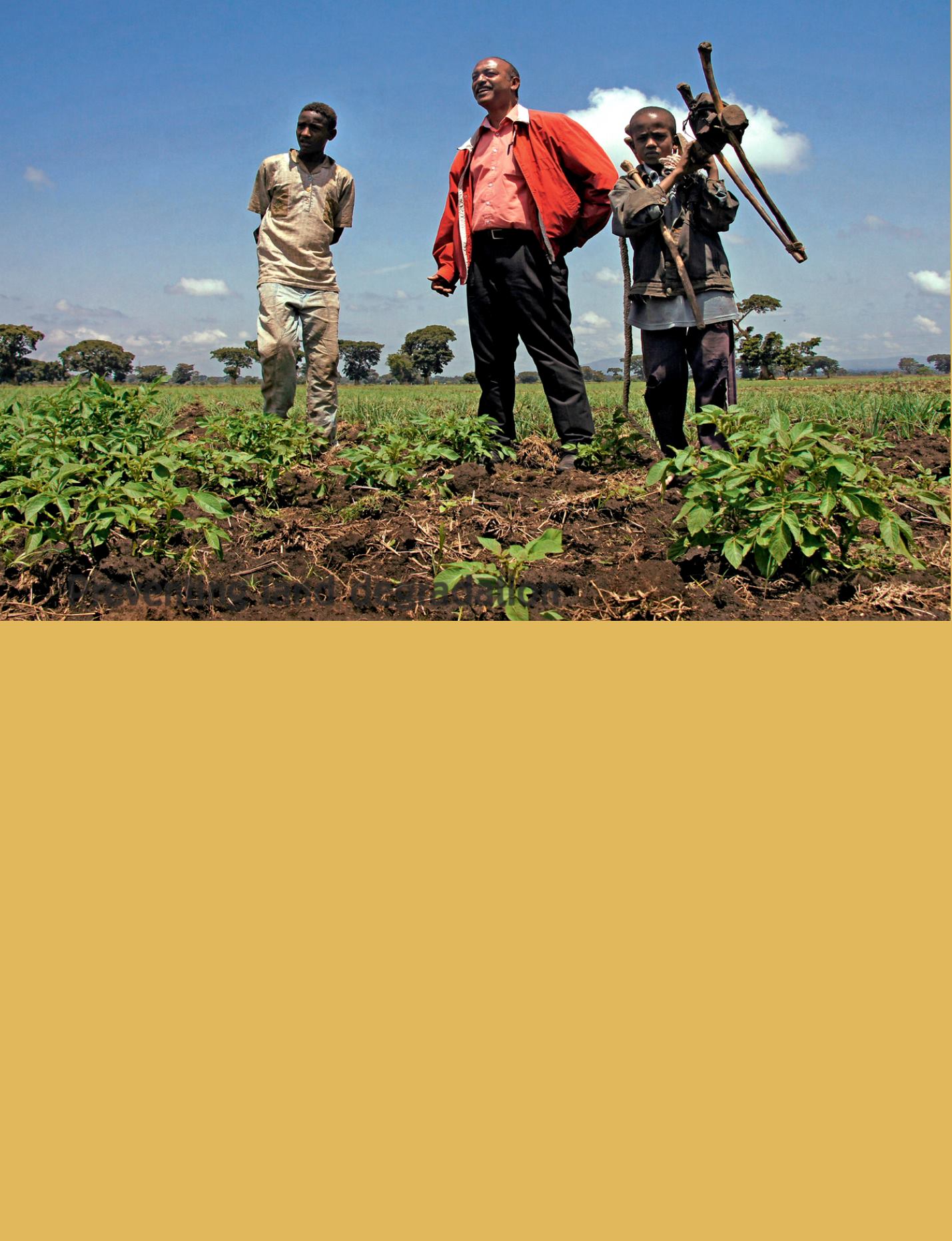
96 - Sustainable Development in Africa & Satellites
i
Pr. Fisseha
Itanna examining crops with farmers Abdusa Kedir and Faruk Adan, near Arsi Negele, Ethiopia
© J.D. Dallet/Suds-Concepts
Preventing land degradation
E
thiopia is endowed with a wide va-
riety of soil types lying in juxtapo-
sition on plains, valleys, undulating
and rugged hills and mountains, and other
landforms. The increased loss of forests
and vegetation cover in natural and far-
ming landscapes over the last three to five
decades resulted in high rates of soil ero-
sion, loss of soil fertility, decreased crop
and livestock productivity and siltation and
contamination of water resources.
Rugged terrain, heavy human and lives-
tock pressure, and poor conservation
measures have further aggravated the
soil deterioration. Appalling scenes of
land degradation are consequently wit-
nessed today in vast areas of the country.
These interwoven problems will directly
affect the sustainability of natural re-
source management and the livelihoods
of the rural poor.
The Ethiopian highlands are the most
intensively cultivated areas, with more
than 88% of Ethiopia’s population de-
pending on these areas for agriculture.
The cereal, livestock, ‘enset’, coffee,
pulses, root crops and chat cultures
are among the most prominent in the
country. Of these, pulses, coffee, lives-
tock and chat are sold to the internatio-
nal market, contributing significantly to
the Ethiopian GNP. Some 27 million ha
representing approximately 50% of the
highlands are already highly degraded.
The Hararghie highlands (Oromia Re-
gion, eastern Ethiopia), Tigrai (Tigrai
Region, northern Ethiopia), Wollo and
Semen Shewa highlands (Amhara Re-
gion, north-central and northern Ethio-
pia), Gamo Gofa highlands and the Bilate
River Basin (Southern Region, southern
Ethiopia) are among the most seriously
degraded land surfaces in Ethiopia.
Loss of organic matter
Poor soil and water conservation mea-
sures coupled with little vegetation cover,
sloping terrain and bad farming practices
have resulted in the land degradation for
example between Modjo and Nazareth,
near Addis Ababa.
Because of serious deforestation in the
area the surface soil material has been
completely removed, leaving the land
bare and subject to erosion. Consequent-
ly, the land has become totally unproduc-
tive, and as a result the community is
abjectly impoverished.
The amount of annual soil movement
(loss) by erosion is estimated to range
from 1248–23400 million tons per year
from 78 million ha of pasture and range
lands and cultivated fields which account
for about 65% of Ethiopia’s land surface.
Associated with the soil movement is the
loss of 15,6, 2,16, and 5,85 million tons of
organic matter, nitrogen, and phospho-
rus, respectively. Of lesser importance
is chemical degradation of soils in urban
settings resulting in soil contamination
from toxic compounds released from in-
dustrial and municipal wastes.
Unless timely measures such as conser-
vation tillage, planting of appropriate
trees for restoration purposes, compos-
ting, crop rotation, terracing, construc-
ting micro-dams, and soil chemical
amendments, etc. are taken, most of the
Ethiopian land under the current envi-
ronmental pressure will continue to be
further degraded and at some places
may even turn into desert. Such concerns
are raised at conferences held by the
Ethiopian Soil Science Society (ESSS),


